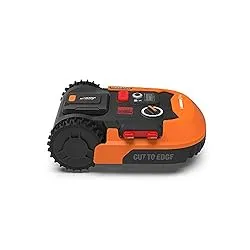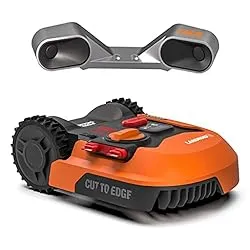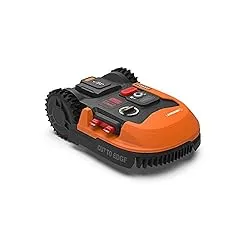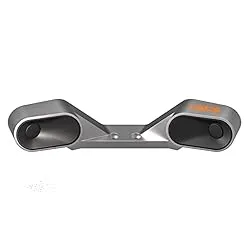WORX Landroid Robot Mower Reviews [+ Comparison Chart]
Robot lawn mowers are becoming a key part of the smart home and one of the brands leading the smart mower revolution is WORX. This is not your typical smart tech brand; it actually has a background in traditional garden and power tools including regular lawn mowers.
Although WORX might not be a household name, they have made products on behalf of Sears and Black and Decker. WORX’s Landroid series of robot mowers was first launched in 2014 and have since become a key player, winning many awards in the process.
In this guide, we’ll share each of the products in the current WORX Landroid range and compare the differences between each.
Table Of Contents
- Comparison Chart
- WORX Landroid S300
- WORX Landroid M700
- WORX Landroid L1000
- WORX Landroid L1500
- WORX Add-on Modules
Comparison Chart
Here is a full comparison table of the key specs for each model:
[table id=8 /]
WORX Landroid S300

The S300 is WORX’s entry level mower that’s designed for small gardens up to 300sqm. It has a 180mm cutting width and is capable of mowing lawns that are slopped up to 27%.
This one doesn’t feature the ‘cut to edge’ technology as this relies on an offset blade, but being a smaller mower than the others, there isn’t enough space for this.
As with all of the WORX Landroid mowers shared here, it can be operated via the onboard keypad or using the companion smartphone app which connects to your WiFi network allowing you to control your mower from anywhere you like. This does mean that the mower needs to be in WiFi range in order to receive commands which may not always be easy if your lawn is some distance from your home.
The S300 is suitable to be used with the 5 WORX add-on modules that can provide extra functionality including anti-collision system or GPS (all five of these are shared at the end of the article).
WORX Landroid M700

The M700 is aimed at small-medium sized gardens with a total area of 700sqm. It manages to do this thanks to a more powerful charger that can recharge the battery quicker and allow the robot to get back out on the lawn. There is also extra boundary wire included to ensure it can be placed around the entire perimeter of your garden.
The M700 has the same cutting width as the S300 at 180mm, however the robot itself is bigger so the blades have been offset in order to allow them to get as close to the edge as possible. The blades themselves have an additional height option as they can be placed at 60mm as opposed to the maximum of 50mm on the smaller model.
You’ll also notice that it’s ability to manage slopes has been improved, it can work on a gradient up to 35% compared to 27% on the S300.
Apart from these differences, the rest of the features on the robot remain very similar. This includes the use of the WORX Landroid app to control your mower, the add-on modules and scheduling.
WORX Landroid L1000

The WORX Landroid L1000 is the newest of those listed here having only launched in 2020 so it features the floating blade deck, this allows the blades to keep a better balance as they go over uneven surfaces.
The cutting width is the same as the M700 at 180mm and also has the offset blades for ‘cut to edge’ technology, however the key difference is the ability to cover a much larger lawn size of 1,000 sqm.
It also has an IPX5 rating which is something not seen on any of the other mowers, this means that it could sustain water from a low powered jet and makes it suitable for washing with a hose pipe.
Although you can only see two wheels when the robot is on the ground, this model does actually have four wheels with the others hidden underneath. This is another difference between this 2020 model and the older models here which all have three wheels.
As with the two previous models, this one can be used with the WORX Landroid app and the plug and play add-on modules can be added.
WORX Landroid L1500

The final mower here is the L1500 which has the highest lawn area coverage at 1,500sqm. It does this thanks to a larger battery than the other models at 4aH and a more powerful base to recharge it.
The L1500 model doesn’t have the floating deck like the L1000 as it was launched much earlier. Instead it has a fixed deck which isn’t as adept at moving over uneven lawns.
Another key factor that helps it cover more lawn is the wider cutting width. At 220mm wide, it’s one of the widest currently on the market in the UK for domestic use.
There are similarities to the lower tier models, this includes the cut to edge technology which sees the blades offset to one site, the ability to use the mower across multiple zones and compatibility with all five add on modules as shared below.
WORX Add-on Modules
All of the WORX Landroid range can be used with the add-on modules which connect to the accessory slots on the mower. Here is a summary of what each module does:
Anti-Collision System

Out of the box, WORX Landroid’s do not have collision sensors. They will bump into objects before reversing to detour around them. For the most part this isn’t too bad, but if you have lots of smaller obstacles such as statues, toys or plant pots on your lawn, it may knock them over.
The ACS module adds ultrasonic sensors to the mower to help detect objects and instruct it to mow around them.
Voice Control
The voice control module does what it says on the tin. It adds voice control functionality to start, stop or set schedules. This is not internet controlled voice activation, you still have to be in range of the mower to use it and it does not integrate with Google Home or Alexa. The module is aimed at those who might not be able to use the onboard keyboard or function a smart phone app such as elderly or visually impaired.
Find My Landroid
The Find My Landroid module adds both cellular and GPS connectivity to your WORX Landroid. It provides two key features:
- GPS to protect your robot mower from theft and provide tracking if it does get stolen. The GPS continues to work even without the battery, so you’ll always be able to locate it.
- Cellular signal provides data connection and means your Landroid doesn’t need a WiFi signal to operate. There is an included SIM card that is prepaid for 3 years and can be renewed afterwards.
Off Limits
The Off Limits module allows you to set additional boundaries in your garden to ring fence objects or areas that you don’t want your mower to attempt.
It includes an off-limits wire which is different from the main boundary wire as it doesn’t need to be powered. You will also be provided with a sensor to connect to the mower itself which detects the off limits wire. This is intended for items like statues, trampolines or plant beds.
Radio Link
As mentioned earlier, all of the Landroid’s can be controlled via the WORX app, however if you have a larger lawn this may be problematic as it utilises your WiFi connection so your robot may not receive the commands. It may also struggle to receive over-the-air software updates.
This is where the radio link module comes in, it creates a 1km radium so that your mower can access the WiFi from much further away.
Featured image credit: WORX